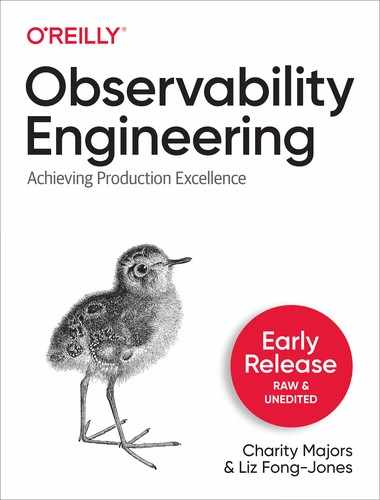Preface
Thank you for picking up our book on observability engineering for modern software systems. Our goal is to help you understand how to develop a practice of observability within your engineering organization. This book is based on our experience as practitioners of observability, and as makers of observability tooling for users who want to improve their own observability practices.
As outspoken advocates for driving observability practices in software engineering, our hope is that this book can set a clear record of what observability means in the context of modern software systems. The term “observability” has seen quite a bit of recent uptake in the software development ecosystem. This book aims to help you separate facts from hype by providing a deep analysis of:
-
What observability means in the context of software delivery and operations
-
How to build the fundamental components that help you achieve observability
-
The impact observability has on team dynamics
-
Considerations for observability at scale
-
Practical ways to build a culture of observability in your organization
Who This Is For
Because observability predominantly focuses on achieving a better understanding of how software operates in the real world, this book is most useful for software engineers responsible for developing production applications. Anyone who supports the operation of software in production will also greatly benefit from the content in this book.
Additionally, managers of software delivery and operations teams who are interested in understanding how the practice of observability can benefit their organization will find value in this book, in particular from any chapters focused on team dynamics, culture, and scale.
Anyone who helps teams deliver and operate production software and is curious about this new thing called “observability” and why people are talking about it should also find this book useful.
Why We Wrote This Book
Observability has become a popular topic that has quickly garnered a lot of interest and attention. With its rise in popularity, observability has been unfortunately mischaracterized as a synonym for monitoring or system telemetry. Observability is a characteristic of software systems. Further, it’s a characteristic that can only be effectively utilized in production software systems when teams adopt new practices that support its ongoing development. Introducing observability into your systems is both a technical challenge and a cultural challenge.
We are particularly passionate and outspoken about the topic of observability. We are so passionate about it, that we started a company whose sole purpose is to bring the power of observability to all teams that manage production software. We spearheaded a new category of observability tools, and other vendors have followed suit.
While the authors of this book all work for Honeycomb, this book is not here to sell you on our tools. Observability can be achieved with different tools and in different ways. However, we believe that our dedication to advancing the practice of observability in the software industry makes us uniquely qualified to write a guide that describes, in great detail, the common challenges and effective solutions.
This book aims to give you a look at the various considerations, capabilities, and challenges associated with teams that practice using observability to manage their production software systems. At times, this book may provide a look at what Honeycomb does as an example of how a common challenge has been addressed. These are not intended as endorsements of Honeycomb, but rather as practical illustrations of abstract concepts. It is our goal to show you how to apply these same principles in other environments, regardless of the tools you use.
What You Will Learn
You will learn what observability is, how to identify an observable system, and why observability is best suited for managing modern software systems. You’ll learn how observability differs from monitoring as well as why and when a different approach is necessary. We will also cover why industry trends have helped popularize the need for observability and how that fits into emerging spaces, like the cloud-native ecosystem.
Next, we’ll cover the fundamentals of observability. We’ll examine why structured events are the building blocks of observable systems and how to stitch those events together into traces. Events are captured by telemetry built into your software and you will learn about open-source initiatives, like OpenTelemetry, that help jumpstart the instrumentation process. Instrumentation exists to analyze system events and you will learn both how that analysis works and how observability and monitoring can co-exist.
After an introduction to the technical concepts behind observability, you will learn about the social and cultural elements that often accompany the adoption of observability. Managing software in production is a team sport and you will learn how observability should be used to help better shape team dynamics. You will also learn about how observability fits into business processes, affects the software supply chain, and reveals hidden risks. You will also learn about the intersection between business objectives, engineering team needs, and user experience that is captured with Service Level Objectives and their role in observable systems.
Observability presents further challenges for large-scale organizations. You will learn about the challenges of efficient data storage for system events, managing large quantities of data with pipelines, deciding when and how to introduce event sampling solutions, and the considerations to take into account when embarking down the path of building your own observability solution.
Finally, we look at organizational approaches to adopting a culture of observability. Beyond introducing observability to your team, you will learn practical ways to scale observability practices across an entire organization. You will learn how to identify and work with key stakeholders, use technical approaches to win allies, and how to make a business case for adopting observability practices.
